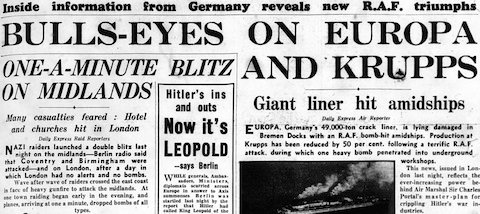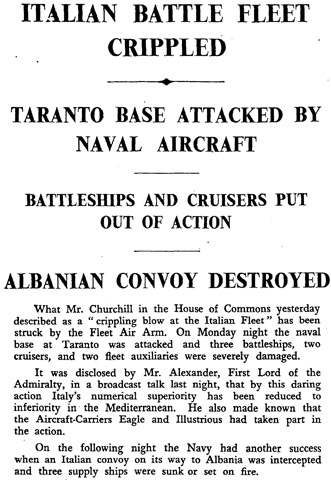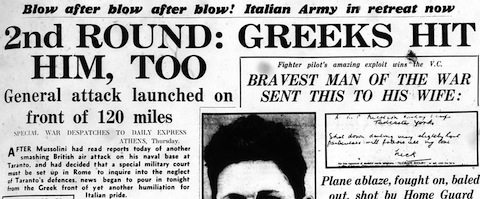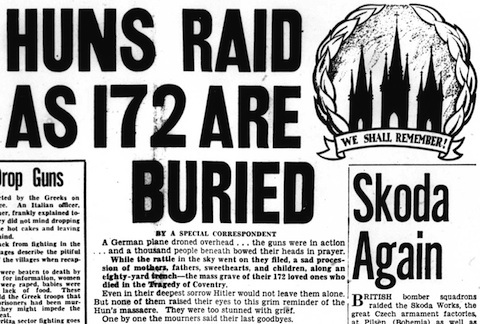
According to the Daily Express, the ‘ever-increasing power behind Air Marshal Sir Charles Portal’s master-plan for crippling Hitler’s war industries’ is beginning to yield results (1). The giant Krupp factory (nearly always rendered as ‘Krupps’ in the British press) at Essen had three ‘sections […] put out of commission’, which must be considered especially impressive as it is ‘officially stated’ that they ‘has been built underground because of their importance’. A big ocean liner, SS Europa, was damaged in an air raid on the Bremen docks. Other targets attacked recently include the oil industry at Hanover (‘completely destroyed’) and the Fokker aircraft factory at Amsterdam.
None of this helped London and the Midlands last night, which were heavily bombed last night. According to German radio, Coventry and Birmingham were said by German radio to be the targets in the latter, though this is not yet confirmed by the government. In one of the towns,
Practically every suburb was involved. Civilian homes were the main target, and several were wrecked before the attack slackened off shortly after midnight.
Damage to industrial buildings was reported to be small.
But ‘Many casualties are feared in the two towns’.
Air defences claimed two bombers destroyed — one by the balloon barrage — and two damaged. The Express dwells on the air defence problem today. Air Marshal Joubert is reported to have said at a luncheon yesterday that ‘The problem of bringing an end to these night raids is very far from being solved’. How far? ‘I won’t delude you by even making a guess.’ He explained that the problem is very difficult:
In this war we are coping with an enemy flying up to three times as fast as they did in the last war (their maximum was about 100 miles an hour), and flying twice as high (12,000 feet last war) — with all sorts of aids to help them to escape detection, special camouflage paint, special attention paid to keeping the flame from the exhaust from showing itself, and so forth.
He does say that ‘We are getting on with it and the scientists are helping as usual.’
But in the end it comes back to training and the skill of the pilot himself, and to his courage and determination — which are factors that fortunately this country is very rich in.
If that’s true, one might ask, why is the problem so difficult? However, I suspect the Express appreciates Jourbert’s relative candour. In its leading article (4), it berates those who pop up now and then to ‘tell us that we are beating the night bomber. Hopes are raised and then the blitz wakes up again.’
The raiders swarm over by the same routes and in greater numbers. They try mass attacks as at Coventry and last week-end in London. And still they get back to their bases.
Of course, the Express doesn’t have the answer, but it urges that ‘Every device, every improvement of existing methods must be tried’. And when it’s found, there’ll be no need for propaganda: it ‘will speak for itself.’
The Horder committee on the improvement of conditions in air raid shelters, appointed back in September, has issued its first report. Most of its suggestions are sensible and uncontroversial: for example, that ‘The provision of first aid points in large shelters should be encouraged’ (The Times, 5). And everyone seems to agree that the committee was right to focus on overcrowding in shelters as the main problem (and the cause of many others, such as poor sanitation). But it seems that there is a difference in opinion on how the first recommendation of the report, that ‘the utmost degree of “dispersal” should be secured’, should be interpreted. The Times agrees, and editorialises that
Every authority who has considered these matters from the point of view both of health and of security has been forced to the conclusion that dispersal is a more practicable form of protection than the construction of deep shelters.
The Manchester Guardian, on the other hand, says (4) of the deep shelter question that:
They left it out of their report, but the members of the committee probably made extremely clear to the Government that the more deep shelter provided in the vulnerable areas the better. It is what the people want, and there is not enough to go round; hence the overcrowding.
Wishful thinking by the Guardian, or a shot across the Government’s bow?

On page 3, The Times publishes a second list of all donations of £20 or more to the Lord Mayor’s Air Raid Distress Fund. I’m pleased to see that topping the list is £40,000 from the Lord Mayor of Melbourne (presumably on behalf of his fellow citizens), making a total so far of £200,000.
![]() This work is licensed under a Creative Commons Attribution-NonCommercial-NoDerivatives 4.0 International License.
Permissions beyond the scope of this license may be available at http://airminded.org/copyright/.
This work is licensed under a Creative Commons Attribution-NonCommercial-NoDerivatives 4.0 International License.
Permissions beyond the scope of this license may be available at http://airminded.org/copyright/.






Pingback: Airminded · Thursday, 21 November 1940